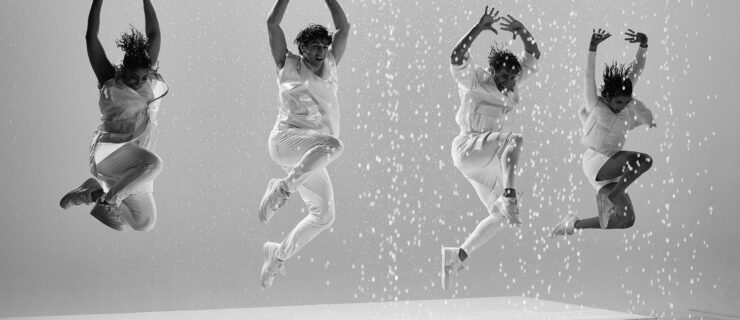Best Face Forward
Any dancer who’s been to competition has seen performers who just don’t know what to do with their faces. They plaster on a smile one moment and look utterly surprised the next. It’s so over the top that it makes you uncomfortable—and maybe even a bit embarrassed for them.
As dancers, we’ve learned to use facial expressions to enhance our routines. But how can you be sure that your expression truly matches your movement? And how much is too much? DS talked to four competition judges to find out what they had to say about the good, the bad and the ugly.
Boost Your Performance
“Your expression adds another dimension to the performance,” says Eddie Strachan, a judge, teacher and choreographer with West Coast Dance Explosion. “No matter what type of dance you’re doing, you’re trying to portray something—a character or an emotion.” It’s all a part of entertaining the audience and making your story believable. “Facial expressions need to come from a real human place instead of being painted on,” says Shelly Masenoir, a judge for StarQuest and Applause Talent Competition and the director of a young choreographers workshop called Uncovered. “Facial expression is not a costume that you put on,” she says. “It’s a part of you and how you feel.”
Although little kids can get away with “the cheesy Kool-Aid smile,” older dancers can’t, says Mark “Biz” Burke, a judge and choreographer with Hollywood Vibe. “You have to dance with your eyes. Your face needs to match what your body is doing, and match the intensity of the music and choreography,” he says. Burke remembers one standout example, a studio that danced to Maroon 5’s “Harder to Breathe.” “The entire dance they were selling it to me,” he says, because the dancers performed the routine as though they were actually gasping for air. “I felt why it was hard to breathe.”
Find a Happy Medium
While it’s important to be intense, there is a risk of overdoing it. When your expression looks forced, the audience and judges can tell. “When you see a piece that is not believable, it’s because the dancers are working from the outside in,” Masenoir says. So what does that mean? Don’t just put on a face because you think it’s what you should look like. Chances are, you’ll look fake. You can’t choreograph your emotions—you have to find the emotion within the movement and the music.
Desiree Robbins, who has been a judge for Tremaine for 18 years, explains that exaggerated, choreographed faces just aren’t natural. “I came across a studio that teaches, ‘When you do a leap, you do this face. When you prepare for a turn, you do this face.’ Then what’s the point of the music?” she asks.
But be careful—zero expression can cost you, too. “If there’s too little expression, I might lower the score,” Robbins says. “There has to be some sort of connection.” Nerves, unfortunately, can hinder this, because you’re likely to pull your performance back when you’re anxious. Overcoming nerves is all about rehearsal. “Practice as much as you can in front of small audiences,” Robbins suggests, “even if you have to pull a friend into the studio while you’re running it.”
Let the Music Guide You
Strachan says the best way to get facial expressions right is to start with the song. “Listen to the story or lyrics, even if it doesn’t pertain to you,” he says. In other words, make the words work for you. Use your own life experiences to trigger emotion.
Burke agrees that facials should come naturally from appreciating and hearing the music. “The more you listen, the more you’ll understand why you want to smile at one point or give an angry face at another,” he explains. When the emotions are genuine, it shows up on your face. “You don’t just live it in your body,” Strachan says, “but behind your eyes and on your face, too.”
Go For It
Great facials don’t just happen onstage; you also have to go full-out during rehearsal. Trust your teacher to tone you down or pull you back, if necessary. “It’s your job to give us something to mold,” Strachan says.
This tactic works for the pros—some of whom take the concept even further. “The Dallas Cowboys Cheerleaders have to practice in full makeup and hair,” explains Robbins, who choreographs for the DCC. “At first, I thought it was goofy, but now it makes sense.” Dancers have to know exactly what it’s going to feel like out on the field or stage. With makeup and hair in place, you can see if a face or gesture will look awkward before the dancer is in front of an audience.
Since most dancers don’t have the DCC coaches to rely on, videotaping is a great way to see yourself. “You can fix a lot of bad habits that way,” Robbins says. “Go for it, then watch yourself.” Another way to double-check yourself is to have a friend watch, even if he or she isn’t a dancer. Ask, “How did this make you feel? Did you get my intention?”
No matter what, it’s important to always dance from the heart, whether it’s at rehearsal or a performance. If you’re genuinely feeling it, your facials will eventually become natural. You’ll be able to portray the story or emotion you’re given. “Whether there are 1,000 people in the audience or one person in the rehearsal room,” Masenoir says, “it should never affect your emotional performance.”



